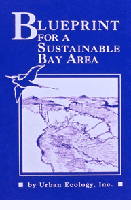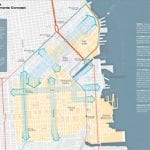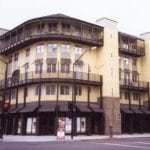Urban Ecology works to build cities that are ecologically thriving and socially just. Developers play a critical role in shaping the Bay Area, and we support development projects that further our vision of a sustainable region. In particular, we encourage “infill” development – building in existing developed areas, rather than in open space and “greenfield” areas.
Urban Ecology offers letters of support to projects that meet our endorsement standards. The criteria in italics are required for full endorsement of a project. Projects that do not meet this standard will be considered on a case-by-case basis for qualified endorsements. Urban Ecology will take into account the local context of each project and the current zoning and development barriers when evaluating projects. The Urban Ecology Board of Directors will periodically revisit these criteria and make revisions as necessary. Developers seeking project endorsements should submit a completed summary worksheet along with a site plan, area map and supporting documentation.
http://www.urbanecology.org/cities/checklist.pdf
Location
Project is located in a built urban setting or within an urban growth boundary approved by voters.
Project site is targeted for revitalization or currently underutilized.
Compactness & Mixed Use
Project has net density of at least 25 dwelling units/acre.
Project supports mixed uses, such as residential and retail.
Housing Choice
At least 20% of residential units are affordable to persons at or below 80% of area median income.
Project includes housing in a range of sizes, types and price levels.
Pedestrian Design
Project design encourages walking and bicycling.
Project incorporates traffic calming or streetscape improvements.
Transportation Choice
Project is located within ¼ mile of a downtown or 1/2 mile of a transit stop with current or planned service levels of at least six vehicles/hour during the peak period.
Project offers alternatives to car ownership and minimizes parking spaces.
Project location has potential for high transit service levels in the future.
Ecological Design
Project has no significant, unmitigatable ecological impacts or environmental hazards.
Project involves cleanup of contaminated sites or restoration of natural habitat.
Project integrates the natural landscape and connects with neighboring open spaces.
Project design uses green building techniques to minimize its environmental impact.
Community Integration
Project sponsor has made a good faith effort to do community outreach and address local concerns.
Project reuses historic buildings or is designed in keeping with local styles.
Project offers significant neighborhood amenities or improvements.
Project Summary Worksheet
Project Name______________________________________________________ City______________
Location ____________________________________________________________________________
Developer ________________________________________________________
Contact Name ____________________________________________________
Phone_____________
Size of site
Total square feet of project
Total square feet of commercial space
Total square feet of open/public space
Allowable density under zoning
Proposed density (units per acre)
Allowable height (ft) under zoning
Proposed height (ft)
Allowable number of stories
Proposed number of stories
Parking spaces required under zoning
Proposed number of parking spaces
# of parking spaces for residential units
# of parking spaces for commercial uses
Does the project include car-sharing?
Are there bicycle facilities in the project?
Total # of residential units
# very-low income units (up to 50% AMI)
# of low-income units (up to 80% of AMI)
# moderate income units (up to 120% AMI)
Number of studio units
Number of 1 bedroom units
Number of 2 bedroom units
Number of 3+ bedroom units
Will any local, state or national historic landmarks be demolished?
Has an Initial Study for CEQA been done?
Are there significant, unmitigatable impacts?
Is the project in an existing urbanized area?
Is this a brownfield site?
Please address the issues below and provide a site plan, sections and elevations of buildings.
1. Describe the project location, current use of the site, and adjacent land uses.
2. Describe any pedestrian and bicycle-oriented design features.
3. Describe type and frequency of transit service within 1/2 mile and pedestrian access to transit stops.
4. Describe any energy efficient or ecological design features.
5. Describe features integrating the natural environment or creating new public spaces.
6. Describe any neighborhood services that will be incorporated into the project.
7. Summarize community outreach conducted and changes in response to any objections and suggestions.
8. Provide a selected list of interested parties, including project supporters and opponents.
9. Explain current stage in the planning and approval process, including upcoming hearing dates.
Project Review Checklist
Urban Ecology also aims to educate citizens, developers, and local governments about the characteristics of exemplary infill projects. This checklist is intended to help citizens and developers evaluate and improve project design during the formative stages. Urban Ecology takes a comprehensive look at development projects, including their location, compact and mixed use features, housing options, pedestrian orientation, transportation options, ecological design and community integration. Generally speaking, the more of these features that are incorporated into a project, the better.
Location
Urban Ecology encourages development in existing urbanized areas, rather than undeveloped “greenbelt” areas on the fringe of the region. So-called “infill” development is a more sustainable use of land and limited public resources. Existing urban areas already have infrastructure and services in place, and it is more efficient to upgrade them for new residents than to stretch out limited funding farther and farther. Even though the supply of urban land is limited, opportunities abound for reclaiming abandoned or underutilized spaces. Building in these areas has far less impact on the environment, and often improves existing conditions.
Is the project in a downtown area?
Is the project location targeted for revitalization?
Is it located near a major employment center?
Does it reuse parking lots, vacant lots, empty buildings, industrial sites, or historic sites?
Does it convert a suburban mall into a mixed-use development?
Does it cluster retail and housing into a suburban sub-center of activity?
Compactness and Mixed Use
Compact developments not only use less land, they encourage development to take a more human-scale. Higher density projects are necessary to support greater frequencies of transit
service and are especially critical near rail transit centers or other major transit nodes. These are the densities necessary to support a lively pedestrian neighborhood, thriving local retailers and commercial activity. Density levels do not have to be uniform throughout the project site.
Unfortunately, proposing greater density evokes negative images for many people, who fear crowded conditions with noise and less privacy. However, in visual preference surveys across
the country, people prefer places where they can walk to local stores and parks. High-quality design is a key to addressing these concerns.
In the ideal mixed-use community, residents provide a market and employees for businesses, and businesses provide desired amenities and jobs for residents. New developments should integrate
and encourage multiple uses (retail, commercial, residential) instead of separating them. It may be desirable or necessary to phase in the different uses for a project. Even in suburban areas, concentrating retail activity and including a mix of residential housing into small centers can reduce automobile dependence.
Is the project’s net density greater than 40 dwelling units acre?
Is the project’s net density greater than 25 dwelling units/acre?
Is the project higher density than the existing neighborhood?
Does the project design cluster buildings on the site, rather than spreading them out?
Does it avoid using large surface parking lots?
Does it integrate residential units with retail, office or cultural uses?
Are multiple uses planned for the project?
Housing Choice
In recent years the Bay Area has experienced a severe housing crisis, triggered by job growth that has far exceeded new housing production. Most new developments have been priced as high
as the market can bear, which is unaffordable to the vast majority of Bay Area residents. Solutions to the housing crisis are complex, and private development projects are part of the
solution. Urban Ecology actively promotes city-wide policies to retain an affordable housing stock and promote the creation of new affordable units. Every city is required to provide their
fair share of affordable housing, based on the projections of the Association of Bay Area Governments.
Urban Ecology believes that housing should range sufficiently in size, type, and price to provide choice to households of all sizes and income levels. For this reason we support new housing
development of all types, including affordable housing, market-rate housing and mixed-income housing. Housing types should include multi-family apartments or condominiums, attached townhouses, single-family and secondary units.
Are units provided for very low income households (up to 50% of area median income)?
Are units provided for low income households (up to 80% of area median income)?
Are units provided for moderate income households (up to 120% of area median income)?
Are units adaptable so that they can be used for live/work?
Are unit sizes varied from studios to 3 or 4 bedrooms?
Does the project include any family-friendly features such as safe play areas for children?
Does the project include secondary units, also known as granny flats?
Is marketing of residential units targeted to employees of nearby businesses?
Are Americans with Disabilities Act (ADA) accessible units included?
Pedestrian Design
Too many American communities have been designed for cars, rather than for people. As a result, many people do not have the choice of walking to visit their neighbors, run errands, or reach community facilities. If we do not want our traffic problems to continue to worsen, new developments must create a supportive pedestrian environment. The necessary physical infrastructure for walking includes sidewalks, crossings, and paths that are safe, connected and unobstructed. Beyond the basics, good streets offer people places for social interaction and a stimulating visual environment.
Does the project incorporate traffic calming strategies, such as narrowing of local streets?
Do proposed sidewalks connect with sidewalks on neighboring streets?
Are all intersections and sidewalks designed for pedestrian safety and accessibility?
Are pedestrian paths or crosswalks to adjacent uses, such as commercial centers, clearly marked?
Are buildings, public spaces, and streets designed on a human scale?
Do buildings have interesting facades, ground floor retail, windows and doors facing the street?
Do sidewalks include trees, pedestrian-scale lighting, and benches?
Does the project provide landscaping rather than concrete barriers along pedestrian walkways?
Does the project mitigate the visual impacts and pedestrian obstacles created by any parking facilities?
Transportation Choice
New developments should be located where good transit service already exists, or where there is a likelihood of future service improvements, such as a historic town center. A project’s transit potential depends not only on proximity to service, but whether the access route is safe, convenient and attractive. If a project addresses an imbalance between jobs and housing, it can also eliminate some commutes. Reducing parking in a project design is one of the most important steps to creating livable, walkable communities. Not only do parking spaces increase the cost for each unit, they detract from the pedestrian orientation and encourage residents to drive. Unfortunately, city zoning ordinances usually demand excessive spaces and obtaining exceptions can be difficult. Numerous creative tools for reducing parking or automobile-dependence are available.
Is the project located at a major transit hub, such as a rail transit center?
Is it located near a transit stop with at least six vehicles per hour during commute hours?
Is there bus, rail or ferry service with at least 15 minute frequencies during commute hours?
Does the project’s location have the potential to support high transit service levels in the future?
Is the parking ratio less than 1:1 spaces per unit?
Is parking less than zoning requirements?
Are car-sharing or car-rental facilities proposed for the site?
Are parking spaces shared between residents and retail uses on-site or with adjacent properties?
Does the project provide or charge for parking spaces separately from residential units?
Does it include bicycle amenities, such as secured bike parking, for both residents and the public?
Are there other features that reduce automobile-dependence?
Ecological Design
Buildings that utilize innovative green design features minimize the environmental impact of new construction. Keep in mind that the location and compactness of a project can have a much greater ecological impact than its design features. Residents of higher-density, transit-oriented developments consume far fewer resources than those in car-based single-family homes. All projects can incorporate natural features into the site plan, either by using existing elements or the creating new green spaces. Projects that restore or improve damaged, blighted or contaminated sites are strongly encouraged.
Does building design and operation minimize energy and water consumption, such as using high insulation and solar orientation?
Does the project utilize or generate alternative energy?
Does it utilize green materials, recycled materials or certified sustainable harvested forest products?
Does it integrate nature into the design, such as creeks, existing trees, or land forms?
Does it connect with neighboring greenways, bikeways and other open spaces?
Does it incorporate urban gardening, green roofs, or other opportunities for contact with nature?
Does it restore natural habitat, such as creeks or native vegetation?
Does it clean up a contaminated industrial site (brownfield)?
Does it include landscaping with native plants that requires minimal irrigation?
Does it utilize natural drainage or permeable ground coverage (ie. brick instead of asphalt)?
Community Integration
A project never stands in isolation, and good infill developments should enhance the livability of their surrounding community. Project designs should be in keeping with local styles, although they may exceed the prevailing density levels. Developers are also encouraged to incorporate neighborhood services into a mixed-use project. Often, there are opportunities to provide parks and other spaces to facilitate neighborhood interactions. Urban Ecology believes that proactive community outreach can improve relations between developers and neighborhood groups. New technologies, visual preference surveys, and interactive meetings can be used for collaborative design. However, a balance must be struck between accommodating neighborhood concerns and addressing city-wide or regional needs for greater density, affordable housing and reduction in automobile use. Infill projects are usually opposed by adjacent neighbors who are concerned about obstructed views, higher densities, low-income housing, and loss of parking. Nevertheless, projects with greater density and reduced parking than surrounding uses may be the most environmentally sustainable and socially equitable options.
Does the building design echo local architectural styles, or improve a blighted area?
Does it reuse or renovate historic structures, rather than demolish them?
Does it include neighborhood-serving uses, such as grocery stores, child care facilities, or cultural
centers?
Does it provide public parks or open space areas where access is not restricted?
Are higher density buildings visually broken up to minimize the appearance of bulk?
Have local stakeholders been encouraged to participate in development decisions?
Has community outreach been conducted in the early, rather than later, stages of project design?
Have reasonable efforts been made to accommodate neighborhood concerns?






